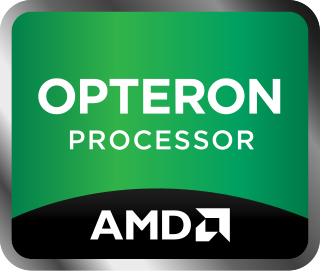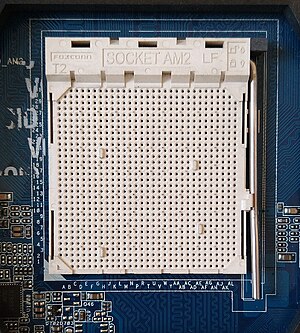HyperTransport (HT), formerly known as Lightning Data Transport, is a technology for interconnection of computer processors. It is a bidirectional serial/parallel high-bandwidth, low-latency point-to-point link that was introduced on April 2, 2001. The HyperTransport Consortium is in charge of promoting and developing HyperTransport technology.

Opteron is AMD's x86 former server and workstation processor line, and was the first processor which supported the AMD64 instruction set architecture. It was released on April 22, 2003, with the SledgeHammer core (K8) and was intended to compete in the server and workstation markets, particularly in the same segment as the Intel Xeon processor. Processors based on the AMD K10 microarchitecture were announced on September 10, 2007, featuring a new quad-core configuration. The last released Opteron CPUs are the Piledriver-based Opteron 4300 and 6300 series processors, codenamed "Seoul" and "Abu Dhabi" respectively.

The Athlon 64 is a ninth-generation, AMD64-architecture microprocessor produced by Advanced Micro Devices (AMD), released on September 23, 2003. It is the third processor to bear the name Athlon, and the immediate successor to the Athlon XP. The Athlon 64 was the second processor to implement the AMD64 architecture and the first 64-bit processor targeted at the average consumer. Variants of the Athlon 64 have been produced for Socket 754, Socket 939, Socket 940, and Socket AM2. It was AMD's primary consumer CPU, and primarily competed with Intel's Pentium 4, especially the Prescott and Cedar Mill core revisions.

Sempron has been the marketing name used by AMD for several different budget desktop CPUs, using several different technologies and CPU socket formats. The Sempron replaced the AMD Duron processor and competed against Intel's Celeron series of processors. AMD coined the name from the Latin semper, which means "always", to suggest the Sempron is suitable for "daily use, practical, and part of everyday life". The last Semprons were launched in April 2014. The brand was retired with the launch of the AMD A-Series APUs.

Socket 939 is a CPU socket released by AMD in June 2004 to supersede the previous Socket 754 for Athlon 64 processors. Socket 939 was succeeded by Socket AM2 in May 2006. It was the second socket designed for AMD's AMD64 range of processors.

Socket 754 is a CPU socket originally developed by AMD to supersede its Athlon XP platform. Socket 754 was one of the first sockets developed by AMD to support their new 64-bit microprocessor family known as AMD64, this time for the consumer market.

Socket 940 is a 940-pin socket for 64-bit AMD Opteron server processors and AMD Athlon 64 FX consumer processors. It was one of the first sockets designed for AMD's AMD64 range of processors.
AMD Cool'n'Quiet is a CPU dynamic frequency scaling and power saving technology introduced by AMD with its Athlon XP processor line. It works by reducing the processor's clock rate and voltage when the processor is idle. The aim of this technology is to reduce overall power consumption and lower heat generation, allowing for slower cooling fan operation. The objectives of cooler and quieter result in the name Cool'n'Quiet. The technology is similar to Intel's SpeedStep and AMD's own PowerNow!, which were developed with the aim of increasing laptop battery life by reducing power consumption.
The AMD Family 10h, or K10, is a microprocessor microarchitecture by AMD based on the K8 microarchitecture. The first third-generation Opteron products for servers were launched on September 10, 2007, with the Phenom processors for desktops following and launching on November 11, 2007 as the immediate successors to the K8 series of processors.

Socket F is a CPU socket designed by AMD for its Opteron line of CPUs released on August 15, 2006. In 2010 Socket F was replaced by Socket C32 for entry-level servers and Socket G34 for high-end servers.

Socket S1 is the CPU socket type used by AMD for their Turion 64, Athlon 64 Mobile, Phenom II Mobile and later Sempron processors, which debuted with the dual-core Turion 64 X2 CPUs on May 17, 2006.

Socket AM3 is a CPU socket for AMD processors. AM3 was launched on February 9, 2009 as the successor to Socket AM2+, alongside the initial grouping of Phenom II processors designed for it. The sole principal change from AM2+ to AM3 is support for DDR3 SDRAM. The fastest CPU for socket AM3 is the Phenom II X6 1100T.

Socket AM2+ is a CPU socket, which is the immediate successor to Socket AM2 that is used by several AMD processors such as Athlon 64 X2. Socket AM2+ is a mid-migration from Socket AM2 to Socket AM3 and both AM2+ and AM2 socket CPUs and motherboards have the potential to operate together. Actual interoperability depends upon other factors, especially the availability of compatible BIOS firmware, and some PC manufacturers, such as Dell, have not provided compatible BIOS versions that allow use of socket AM2+ CPUs on their products utilizing socket AM2 motherboards, such as the Inspiron 531. It was released in November 2007.
The AMD Bulldozer Family 15h is a microprocessor microarchitecture for the FX and Opteron line of processors, developed by AMD for the desktop and server markets. Bulldozer is the codename for this family of microarchitectures. It was released on October 12, 2011, as the successor to the K10 microarchitecture.

Phenom II is a family of AMD's multi-core 45 nm processors using the AMD K10 microarchitecture, succeeding the original Phenom. Advanced Micro Devices released the Socket AM2+ version of Phenom II in December 2008, while Socket AM3 versions with DDR3 support, along with an initial batch of triple- and quad-core processors were released on February 9, 2009. Dual-processor systems require Socket F+ for the Quad FX platform. The next-generation Phenom II X6 was released on April 27, 2010.

Athlon II is a family of AMD multi-core 45 nm central processing units, which is aimed at the budget to mid-range market and is a complementary product lineup to the Phenom II.












